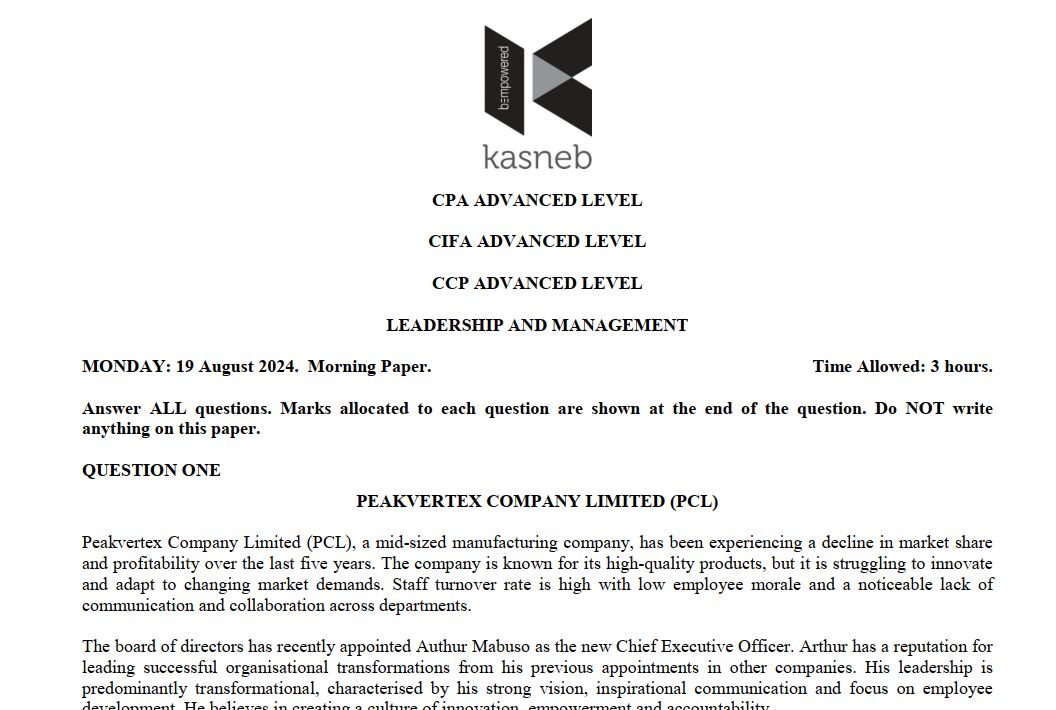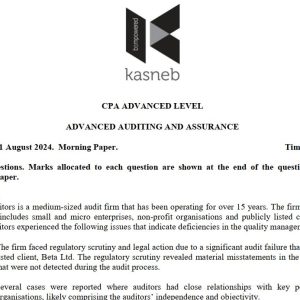Description
CPA ADVANCED LEVEL CIFA ADVANCED LEVEL CCP ADVANCED LEVEL
LEADERSHIP AND MANAGEMENT
MONDAY: 19 August 2024. Morning Paper. Time Allowed: 3 hours.
Answer ALL questions. Marks allocated to each question are shown at the end of the question. Do NOT write anything on this paper.
QUESTION ONE
PEAKVERTEX COMPANY LIMITED (PCL)
Peakvertex Company Limited (PCL), a mid-sized manufacturing company, has been experiencing a decline in market share and profitability over the last five years. The company is known for its high-quality products, but it is struggling to innovate and adapt to changing market demands. Staff turnover rate is high with low employee morale and a noticeable lack of communication and collaboration across departments.
The board of directors has recently appointed Authur Mabuso as the new Chief Executive Officer. Arthur has a reputation for leading successful organisational transformations from his previous appointments in other companies. His leadership is predominantly transformational, characterised by his strong vision, inspirational communication and focus on employee development. He believes in creating a culture of innovation, empowerment and accountability.
Upon joining PCL, Arthur conducted a comprehensive analysis of the company’s operations, market position and employee satisfaction. The following issues were identified:
• Outdated product lines and lack of innovation.
• Siloed departments with poor inter-departmental communication.
• Low employee engagement and high staff turnover.
• Inefficient processes and lack of clear direction.
Arthur’s first major initiative was to launch a company-wide transformation programme dubbed “PCL revamped”, aimed at revitalising the company’s culture, processes and market research. The programme includes the following components:
• Implementing cross-functional teams to drive product innovation and improve market responsiveness.
• Implementing leadership training programmes to develop current and future leaders within the organisation.
• Introducing initiatives to boost employee morale, such as recognition programmes, flexible work arrangements and open forums for feedback.
• Streamlining operations by adopting new technologies and improving workflow efficiencies.
• Implementing a client feedback loop to continuously improve service quality and strengthen client relationship.
However, Arthur faces the following challenges in implementing “PCL revamped”:
• Resistance to change from long standing employees.
• Aligning the diverse goals and expectations of various stakeholders.
• Maintaining operational stability while executing major changes.
• Ensuring quick adoption of new technologies and processes.
• Balancing short-term and long-term strategic goals.
Within the first six months, PCL revamped has shown promising results. Early innovations from the hubs have led to the development of two new product lines which are yet to be launched into the market. Employee engagement scores have improved and there is a noticeable increase in collaboration across departments. However, some resistance remains and Arthur is working on addressing these issues through continued communication and support.
Required:
(a) Explain FIVE objectives of innovation hubs in the context of “PCL revamped”. (5 marks)
(b) Suggest FOUR potential strategies that Arthur could use to overcome resistance to change among the long standing employees. (4 marks)
(c) Analyse FOUR potential long-term impacts of the “PCL revamped” programme on the company’s culture and market position. (4 marks)
(d) Evaluate THREE roles of leadership development in the success of “PCL revamped”. (6 marks)
(e) Discuss THREE roles of client feedback in enhancing PCL’s service quality and client relationship. (6 marks)
(f) Explain THREE differences between “strategic goals” and “operational goals” in the context of PCL. (6 marks)
(g) Highlight FOUR ways in which the Chief Executive Officer may address the challenge of balancing short-term operational needs with long-term strategic goals. (4 marks)
(h) Advise the Chief Executive Officer and his team on FIVE alternative pricing strategies that the company could adopt when introducing the new products. (5 marks)
(Total: 40 marks)
QUESTION TWO
(a) Describe FIVE factors that are reshaping and redefining management in modern day organisations. (5 marks)
(b) Discuss FIVE benefits of application of Henry Fayol’s administrative theory to a modern organisation. (5 marks)
(c) Analyse FIVE factors that have led to a shift towards quantitative thinking and decision making in many organisations. (5 marks)
(Total: 15 marks)
QUESTION THREE
(a) Explain FIVE limitations associated with management that over rely on micro-environmental factors in decision making. (5 marks)
(b) Identify FIVE circumstances under which compromise can be used as a strategy in conflict resolutions. (5 marks)
(c) Discuss FIVE benefits of understanding the conditions under which managers are required to make decisions. (5 marks)
(Total: 15 marks)
QUESTION FOUR
(a) Explain FIVE challenges encountered by managers during formulation stage of organisational strategic direction. (5 marks)
(b) Illustrate FIVE different stages of the project life cycle. (5 marks)
(c) Explain FIVE benefits of segment evaluation before development of marketing information. (5 marks)
(Total: 15 marks)
QUESTION FIVE
(a) Discuss FIVE ways through which organisations could enhance entrepreneurial development culture amongst employees. (5 marks)
(b) Theories of change enhance the likelihood of successful change initiatives by addressing challenges, engaging stakeholders and aligning the organisation with its strategic objectives.
With reference to the above statement, describe FIVE roles of theories of change in an organisation. (5 marks)
(c) Analyse FIVE ways that can be applied by organisations to manage employee performance. (5 marks)
(Total: 15 marks)





Reviews
There are no reviews yet.